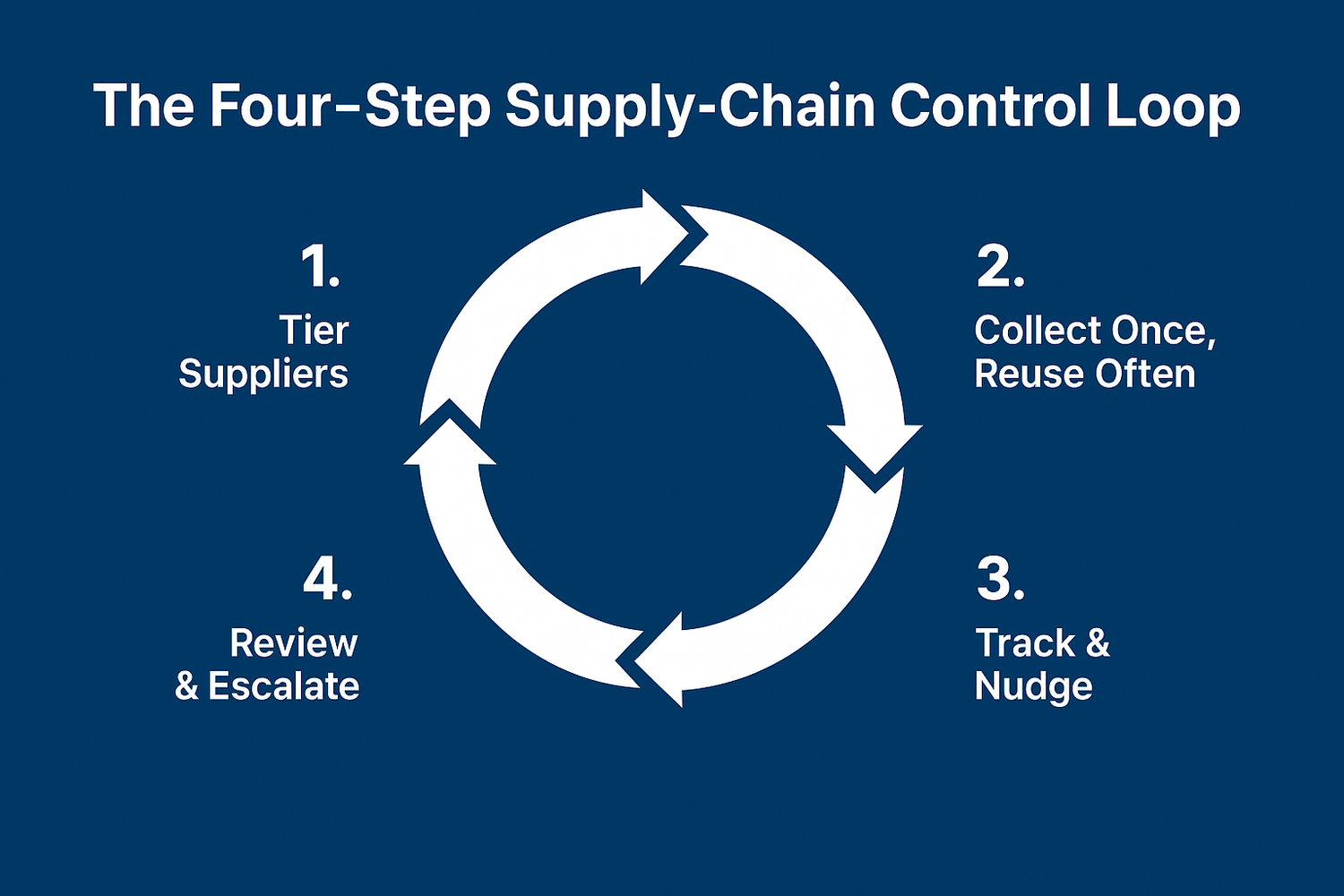Supply-Chain Slip-Ups: How DIB Contractors Can Tame the “Flow-Down” Compliance Chaos
The Pain Point—When Your Vendor Becomes Your Weakest Link
Congratulations—you’ve nailed your own CMMC controls, uploaded a respectable SPRS score, and scheduled the C3PAO. Then the prime’s subcontractor risk team emails a simple question:
“Provide evidence that every Tier 2 supplier handling CUI is meeting NIST 800-171.”
Suddenly you’re chasing twenty machine shops, two finishers, and a software vendor for artifacts they’ve never heard of. Each one sends a different format—Excel checklists, blurry PDFs, even smartphone photos of policy binders. Now you look disorganized, and worst-case the entire contract pauses until the flow-down mess is sorted.
Why it Hurts
Administrative drag – months of email ping-pong and “just following up” calls.
Bid risk – primes score vendor cyber posture in source selections; a sloppy supply-chain file can sink your price advantage.
Audit exposure – the DoD guidance is clear: if your subs touch CUI, you’re on the hook for their controls too.
Let’s fix it—without adding another six-figure consultant line item.
Know Your Flow-Down Obligations (in Plain English)
DFARS 252.204-7012 requires any subcontractor that receives, transmits, or stores CUI to implement NIST 800-171 (and soon CMMC Level 2).
CMMC 2.0 makes the prime (or higher-tier sub) prove that lower-tier vendors are on track.
Contracting officers reserve the right to request evidence of flow-down at any time.
Translation: keeping your own house in order isn’t enough—you need a tidy digital folder that shows each supplier’s compliance journey.
The Four-Step Supply-Chain Control Loop
You don’t need a vendor risk management platform the size of Boeing’s to stay compliant—you need a repeatable, low-friction process that keeps your suppliers on track. Here's the loop we recommend running quarterly:
Step 1: Tier Your Suppliers
Group vendors based on how they interact with Controlled Unclassified Information (CUI).
Tier 1: Direct access to CUI — requires full NIST 800-171 implementation and SPRS score.
Tier 2: Indirect or adjacent access — needs MFA, encryption, and a signed policy acknowledgment.
Tier 3: No CUI access — basic cyber hygiene and awareness training is enough.
Step 2: Collect Once, Reuse Often
Standardize your questionnaire. Ask for the same documents every time:
Company profile (CAGE, DUNS)
Current SPRS score
System Security Plan (SSP)
POA&M summary
Point of contact for incident response
This way, every vendor gives you the same core package—no formatting chaos, no back-and-forth.
Step 3: Track & Nudge
Use software—or at least a calendar—to send automated reminders ahead of due dates. Track who’s red, yellow, or green. Escalate only after friendly follow-ups don’t work.
Step 4: Review & Escalate
Don’t wait for the audit to find out who’s behind. Review your vendor compliance dashboard monthly. For those struggling, offer templates, intro sessions, or IT support. If they still can’t comply, log your outreach and flag the risk to the contracting officer.
This four-step loop turns chaotic inboxes and inconsistent documentation into a predictable process you can repeat every quarter—without burning out your ops team.

Tiering Suppliers—Not Every Vendor Needs Level 2
How one aerospace integrator did it
Tier 1: Direct CUI access
CNC houses, design partners, SaaS hosting controlled tech data.
Must show documented 800-171 controls + SPRS score.
Target CMMC Level 2 within 18 months.
Tier 2: Indirect but adjacent
Calibration labs, IT managed-service providers, field-repair crews.
Must show signed obligations + proof of encryption and MFA.
Self-attest at Level 1 now, Level 2 only if contract scopes expand.
Tier 3: No CUI touch
Office supplies, janitorial, temp agencies.
Awareness training and basic cyber hygiene sufficient.
They loaded this logic into TryComplai once; new vendors select the tier from a drop-down and see only the relevant evidence list. No more “why are you asking for my MFA logs, we just sell nitrile gloves.”
DIY tip: If you’re spreadsheet-only, start with three columns: Vendor, Data Touch, Required Evidence. Even a simple matrix avoids blanket emails that alienate small suppliers.
Collect Once, Reuse Often—The Universal Questionnaire
Most flow-down requests fail because every prime (or even every department) invents a new form. Pick a universal set and stick with it:
Company profile (CAGE, DUNS, NAICS).
Latest SPRS score and date submitted.
Copy of System Security Plan (redact sensitive IP).
POA&Ms summary with realistic completion dates.
Contact for cyber incidents (mandatory under DFARS 7012).
Pro tip: Ask for file formats you can parse—CSV for scores, PDF for SSPs, XLSX for POA&Ms. Consistency feeds dashboards later.
How TryComplai does it
The Vendor Module ships with a drag-and-drop questionnaire builder. Answers land straight into each supplier’s card; duplicate questions auto-resolve so the vendor never re-keys data they provided last quarter.
DIY tip: If you can’t swing a platform yet, create a single SharePoint folder with templated sub-folders—“01_SPRS”, “02_SSP”, “03_POAM”. Share the folder link, not email attachments. It’ll still save hours.

Track & Nudge—Automation Over Nagging
Remember the inbox chaos when you asked four vendors for status? Multiply that by forty. Humans forget; software pings.
Smart nudging checklist
Evidence Automation & GRC Dashboards
Due-date calendar – 30-, 14-, and 3-day reminders.
Traffic-light dashboard – green = complete, yellow = partial, red = overdue.
Escalation ladder – after two missed reminders, CC a manager or your buyer.
A DoD electronics supplier using TryComplai reported a 57 % drop in “just checking in” emails after automated nudges. Their purchasing team reclaimed two days per month—without hiring another analyst.
DIY tip: Even Outlook rules + conditional formatting can create a color-coded inbox. Not as slick, but better than manual sorting at midnight.
Review & Escalate—Helping, Not Shaming
Inevitably a vendor will lag. Resist the urge to blast them. Instead:
Offer a starter kit – template SSP, POA&M guide, MFA how-to’s.
Pair them with your IT team for a one-hour workshop.
Set milestone reviews rather than a big-bang deadline.
A metal finishing shop we coached went from zero controls to an 88-point SPRS in six weeks after receiving a pre-filled POA&M template and an intro to low-cost log collectors. They stayed in the contract, and our client avoided a costly vendor swap-out mid-production.
Escalation: If, after support, a vendor still won’t engage, document every attempt, flag the risk in your compliance portal, and notify the contracting officer. Showing your diligence protects you from liability.

Success Story—From Chaos to Clarity in Three Months
The Situation
A 120-person systems integrator juggled 68 active suppliers. Audit week revealed none had uploaded current SPRS scores; twenty had never heard of NIST 800-171.
The fix
Month 1 – Loaded all vendors into TryComplai, tagged tiers, and sent the universal questionnaire.
Month 2 – 70 % completion. Automated reminders cut idle follow-ups by half.
Month 3 – Final laggards received a workshop and template pack; risk report turned from red to green.
Outcome
Audit passed on first swing.
Procurement cycle times dropped 22 %.
Two small machine shops improved security and thanked the integrator for the “push”—talk about relationship ROI.
Quick-Hit Toolkit—What You Need to Get Started Tomorrow
Here’s what you can set up immediately—whether you’re starting with spreadsheets or using a platform like TryComplai:
Tiering Logic
DIY: Build a simple Excel sheet to categorize vendors as Tier 1 (CUI access), Tier 2 (adjacent to CUI), or Tier 3 (no CUI).
Scalable: Use TryComplai’s built-in vendor tiering options with pre-configured control requirements per tier.
Questionnaire Delivery
DIY: Create a single, reusable form using Word or Excel; host it on SharePoint or Google Drive for consistency.
Scalable: Build and send drag-and-drop forms inside TryComplai; responses auto-sync to each vendor record.
Summarise these gains in a one-page dashboard and you’ll have the story the CFO needs—without quoting a single licence number.
Reminders and Follow-ups
DIY: Set recurring calendar invites or email reminders in Outlook or Gmail.
Scalable: Automate nudges based on due dates inside TryComplai, with escalations for non-responses.
Document Collection and Storage
DIY: Set up individual folders for each vendor in OneDrive or Dropbox, using a consistent naming structure (e.g., "VendorName_SSP").
Scalable: TryComplai provides secure upload portals with AES-256 encryption and structured document tagging.
Status Reporting
DIY: Use a pivot table or conditional formatting in Excel to visualize vendor status.
Scalable: TryComplai offers a real-time vendor compliance dashboard with green/yellow/red indicators based on control completion.
Even if you're not ready to adopt a full platform, building these habits early will keep your vendor risk efforts sane—and auditable.
Final Word—Supply-Chain Security Is Team Sport
CMMC isn’t a walled garden; it’s a relay race. Your baton is only safe if the next runner’s grip is ironclad. By tiering suppliers, standardizing evidence requests, and automating reminders, you turn chaos into cadence—and prove to primes (and the DoD) that you’re a low-risk, high-value partner.
Ready for zero-stress flow-downs? Spin up a free TryComplai sandbox, add three vendors, and watch the dashboard light up. You’ll never send another “just checking in” email again—and your supply chain will thank you for it.
Frequently Asked Questions
Yes—if your subcontractors handle Controlled Unclassified Information (CUI), you are responsible for ensuring they meet NIST 800-171 requirements. Even if you're not the prime, flow-down clauses in DFARS 252.204-7012 make you accountable for your vendor’s cybersecurity posture.
Start by asking one question: Do they access, store, or transmit CUI? If yes, they’re Tier 1. If they’re adjacent but don’t touch CUI (like your MSP), they’re Tier 2. Everyone else—janitorial, delivery services, etc.—can be Tier 3. Tag them accordingly and tailor evidence requests based on that tier.
Quarterly is ideal. Use a standard questionnaire and automate reminders. TryComplai customers often set 30-, 14-, and 3-day check-in cycles before marking vendors non-responsive. Continuous engagement reduces fire drills before audits.
Start by offering support—templates, training, or even a walk-through of expectations. If they still can’t comply and CUI is involved, you may need to escalate the issue internally or find a replacement. Always document your outreach efforts to protect your audit trail.
Yes, but be realistic about scale. For fewer than 10 vendors, spreadsheets and folders might work. Once you hit double digits—or have mixed tiers and multiple primes—automation becomes essential. That’s where tools like TryComplai save dozens of hours per quarter and make you look organized when primes or auditors come calling.

POPULAR POSTS

by Mike Hayles- July 5th, 2025
By Mike Hayles on June 26th, 2025
By Mike Hayles on June 28th 2025
NEWSLETTER
Subscribe to our mailing list to get the new updates.






